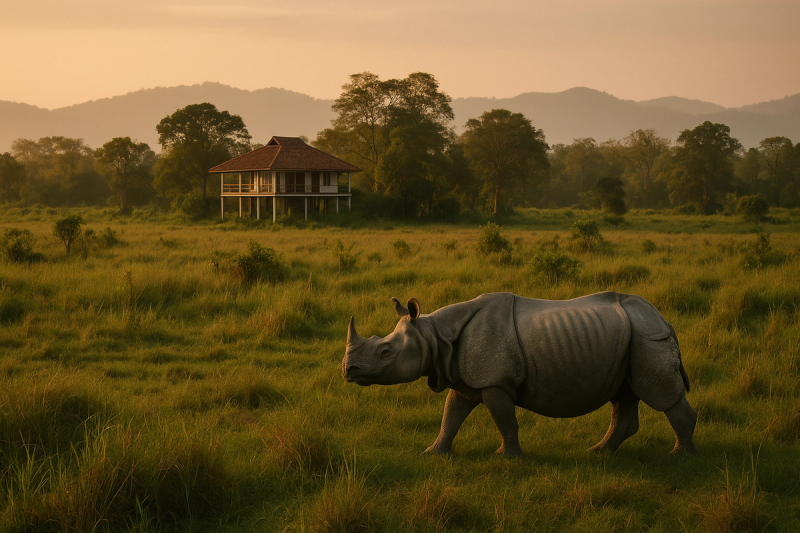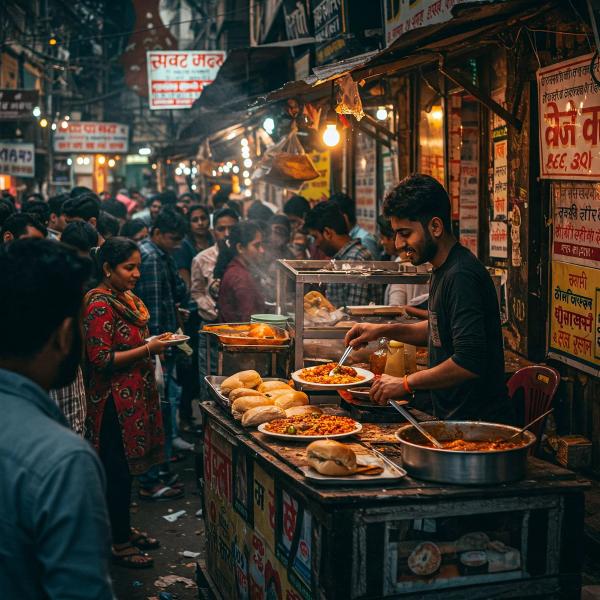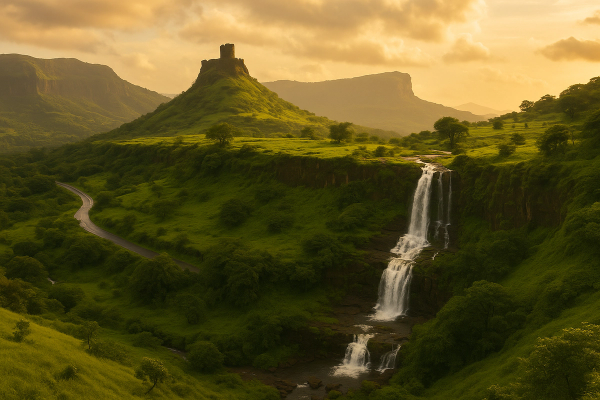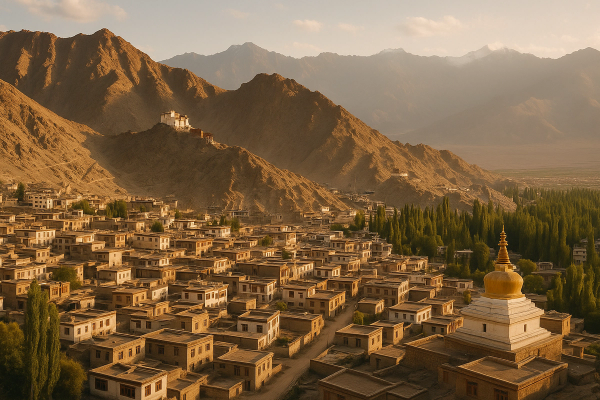Kaziranga Safari Guide: Rhino Encounters, Best Seasons & Stays — a very real, very desi take#
Okay, so quick heads-up before we dive in. This is a first-persony guide stitched from on-ground chats with local guides, homestay folks, forest staff, and friends who’ve done Kaziranga in the last year or so. I’m writing it the way I’d tell my cousins on WhatsApp — casual, chatty, a little messy — coz honestly that’s how we talk travel. No fake bragging about “I alone discovered it”. It’s more like the community-gyaan you recieve when you keep asking questions till the tea gets cold. And Kaziranga, yaar… it’s not just a park. It’s a mood. Big skies, elephant grass taller than your ego, rhinos that look like tiny tanks, and that soft winter light that makes everything look like a movie. UNESCO World Heritage yes, but also very Assam — slow, green, generous. And lately, the conservation wins have been real. Assam govt even reported zero rhino poaching in recent years, which… touchwood. That’s huge.¶
Rhino encounters: where, when, how to actually see them up-close (but not too close)#
If you want that first proper goosebump moment with a one-horned rhino, the Western Range (Bagori) is your best shot. The grasslands open wide, and the tracks skirt waterbodies where rhinos munch like they own the place. Central (Kohora) gives you balanced sightings — rhinos, elephants, swamp deer, even a surprise wild buffalo. Eastern (Agaratoli) is for the patient birders and people who hate crowds. And Burapahar is moody — forested, hilly, sometimes very quiet and then suddenly… boom, a family of elephants. Mornings are gold. Winter mornings can be foggy as chai, so give the fog 15–20 minutes to lift. Guides know the regular wallow spots and salt licks. Don’t be shy to ask them to move slow or stop a bit longer. Rhinos are chill if you keep distance and stay in the jeep. No flashy selfies, no “bhai, zara aage le jao” drama. Remember, they can run. Faster than your Jio network when it rains.¶
Best seasons to visit (not just “winter good, monsoon bad”) — the real breakdown#
Nov to Feb is the classic sweet spot — cool weather, shorter grass after the annual cutting and controlled burning, and loads of migratory birds. Early mornings can be biting cold, especially Dec–Jan, but that crisp light is chef’s kiss and the rhinos pop against the golden grass. Mar to mid-Apr is underrated. Days get warmer, visibility is great, and animals stick closer to water. Fewer fog delays, more time in the field. It’s also pre-Bihu energy in Assam, so the vibe in towns is festive. End-May to Oct is monsoon season and the park mostly shuts down. Floodplains flood, quite literally. That flooding is natural and actually good for the eco-system, but for safaris it means wait it out. Some peripheral or buffer areas may open earlier or later depending on water levels, but core zones are typically off-limits. If you’re allergic to crowds, avoid Christmas–New Year and long weekends. Bookings get snapped up faster than jalebis outside a wedding.¶
Getting there without drama — flights, trains, roads, and jugaad#
The closest big airport with frequent flights is Guwahati. From there it’s roughly 4.5–5.5 hours by road to Kaziranga (around 220 km, give or take). Jorhat airport is closer, about 100–110 km, ideal if you find a good fare. Tezpur has an airport too, but flights are fewer. By train, Furkating (near Golaghat) is the nearest functional junction for many travellers, though many folks do Guwahati by rail and then road. Roads are mostly decent now on the NH route, with patches where four-laning work keeps happening. You’ll pass tea estates, haats, and that endless green. If you don’t wanna drive, ASTC buses and shared Sumos run Guwahati–Kaziranga–Jorhat routes. Private taxis from Guwahati airport are straightforward; just negotiate clearly. Network is mostly fine along the highway — Jio/Airtel work — but inside the park, no signal. Which, honestly, is the point.¶
Safaris & permits, explained like I would to my chachu (aka no jargon)#
Safaris are either jeep or elephant. Jeep safaris run two shifts typically — early morning and afternoon — with exact timings tweaked by season and light. You book a jeep, not a seat, and it fits around 6 people. Ballpark costs: 2500–4500 INR per jeep per ride depending on zone/season/operator, plus forest entry fees per person, plus guide fee assigned at the gate, plus camera fees if you’re carrying DSLRs. Prices move, so don’t @ me if they bump it this season. Booking: you can reserve through the official Kaziranga channels or registered operators. An online permit system is available for jeeps in many cases, though counters still exist at the ranges for last-minute permits. Carry original IDs. Show up 30–40 mins early. Elephant safaris, currently running in limited capacity in select ranges, are a hot potato. Seats are few, queues are real, and there’s debate on ethical concerns. Many Indian travellers now skip the elephant rides and just do multiple jeep loops instead. My two paise: if you do choose it, do it responsibly, check current rules, and prioritize operators following welfare norms. Also, don’t worry about “foreigners getting priority” and all those rumours. The system changes and is more streamlined now — just check the official notice before you plan.¶
Which zone suits you — quick and honest cheat-sheet#
Bagori (Western): Classic rhino country, wide vistas, great for first-timers and families. Kohora (Central): Balanced sightings, varied habitat, easy logistics. Agaratoli (Eastern): Birding paradise, fewer jeeps, excellent for people who like quiet. Burapahar (Ghorakati): Forested and hilly, fewer rhinos but moody and beautiful, occasional elephants and primates. If you have two rides, pair Bagori + Kohora. Three rides, add Agaratoli. Fourth ride, chase your favourite. Guides will often nudge you based on latest movement — trust that intel.¶
Where to stay: from cozy camps to the fancy stuff (and what’s worth your money)#
Kaziranga has that full spectrum. On the comfy-but-not-crazy side you’ve got places around Kohora like IORA The Retreat, Borgos, Infinity Resorts. They’re polished, good for families and groups, pool sometimes, lawns to loaf around, and strong breakfasts. Mid-range charm picks include Wild Grass Lodge, which has old-school vibes and a loyal fan club, and a bunch of tidy homestays and eco-camps scattered along the highway. Budget travelers and backpackery folks do well with simple cottages and homestays starting 1200–2500 INR per night for double rooms, clean and cheerful, often with very good home-food. Top-end luxury? Diphlu River Lodge is the name you hear a lot — boutique, serene, wildlife-first. It’s not cheap, think upwards of 25–35k INR a night in peak, but the experience is curated. Slightly away but lovely is Koliabor Manor in a tea estate setting, which some couples pick for the setting and drive in for safaris. As a rule, mid-range stays call it around 4000–9000 INR per night depending on season. Festival weeks and Dec–Jan spike. Book early for winter, like seriously. Don’t overthink location too much — if you’re near Kohora or Bagori you’re sorted, and even Agaratoli runs fine with an early start.¶
Food, tea, and those little Assamese comforts that make the trip feel homely#
Pick a thali and you’ll understand Assam. Think steaming rice, dal, aloo pitika, lai xaak, xukoti chutney sometimes, tangy masor tenga if you eat fish, pork with bamboo shoot if you like a punch, duck curry on a good day, and that subtle balance of spice and sour and smoke. Breakfast jolpan — chira doi gur — will hug your soul. If you see pitha in winter, just don’t say no. Around Kohora, “Maihang” is the name locals keep tossing at me for solid Assamese meals. Highway dhabas are excellent too, very no-frills. Tea is everywhere, and the Hathikuli Tea Estate outlet on the highway is a nice pitstop to buy packets back home. Rice beer exists in tribal communities — if you’re offered locally and it’s legal in that setup, sip slowly and respectfully. Vegetarians won’t struggle at all, and gluten-free folks can stick to rice and curries. Oh and please, hydrate — safaris dry you out more than you realise.¶
Offbeat and birding detours when you’ve got an extra day (or just a restless heart)#
If you’re into birds, Agaratoli itself will keep you smiling — brahminy ducks, storks, kingfishers, the works. Panbari Reserve Forest is a quiet haunt for hornbills and forest species, best with a local guide who knows the trails. Deopahar near Numaligarh has an old-world vibe with ruins and a hill view that’s very photo-friendly. If you’ve got an extra 2–3 days, Nameri National Park near the Assam–Arunachal border makes a lovely extension for birding and the gentle Jia-Bhoroli rafting. And if culture calls, Majuli Island on the Brahmaputra is a whole other mood — satras, masks, and sunsets that refuse to end.¶
Safety, etiquette, and just being a decent human in a tiger reserve#
Inside the park: no getting off the jeep, no shouting, no feeding, no littering. Wear muted colors, ditch strong perfume, and keep phones on silent because that TikTok tune at a rhino sighting is… nah. Maintain distance. Your guide isn’t being fussy, they’re keeping you and the animals safe. Don’t pressure drivers to crowd an animal. If a tusker blocks the track, wait. Outside the park: roads have active wildlife corridors — slow down where it’s signed. Nights can be foggy in winter, so drive with patience. Health-wise, carry a light jacket, cap, sunscreen, a small first-aid pouch, and any meds. Leeches aren’t a big menace in the main safari area, but monsoon hikes elsewhere can have them, so long socks if you must. Cash and UPI both work, but ATMs can be patchy — keep some notes handy. And please, no drones unless you like fines and confiscation.¶
Budgeting made simple + a real 2N/3D plan that doesn’t feel rushed#
For a comfortable mid-range 2 nights, think roughly: stay 6–10k per night for a double, two jeep safaris at say 3–4k each per jeep plus entry and guide fees, food around 700–1200 per person per day if you’re eating well, transport from Guwahati by private car about 8–12k roundtrip depending on your negotiating superpowers. Split among 4 people, it suddenly looks very doable. A quick plan: Day 1 noon reach, chai, afternoon jeep at Bagori. Dinner Assamese thali, sleep early. Day 2 early jeep at Kohora, late breakfast, chill in the day, tea estate visit or a village walk with a homestay host, then an optional afternoon jeep at Agaratoli if you’re feeling greedy. Day 3 slow breakfast, buy tea and bamboo shoot pickles for ma, drive back. If you’re going hardcore on sightings, do three jeep rides minimum. If you’re going hardcore on feelings, sit by the grassland edge and just listen to the wind. Both are valid itineraries, haan.¶
What to pack (and what most folks forget)#
Layers for mornings, a light fleece or shawl, cap/hat, sunglasses, a rain shell if you’re flirting with shoulder season, closed shoes, binoculars if you have them (even a modest 8x42 makes a huge difference), power bank, refillable bottle, small torch, photocopies of IDs, and some snacks that don’t melt or crumble like your patience. Camera people — extra batteries, bean bag instead of a tripod. And keep a small trash bag in your daypack. Leave no trace, not even your favourite chips packet.¶
How booking actually plays out (no sugarcoating)#
Peak weekends get sold out fast — stays and safaris. If you’re picky about zone, book earlier. Many legit operators will sort permits, guide, and jeep in one go and WhatsApp you the details. Always ask for final inclusive cost, zone, and meeting point. If you’re trying the government counters, reach early morning with IDs. Elephant rides, when open, are first-come and super limited — families line up at dawn. Personally, I think doing two jeeps in different zones beats stressing over one 40-minute elephant ride you may not even get. Your call though. In any case, keep a Plan B zone in mind coz adjustments happen due to weather, track conditions, or wildlife movement.¶
Current vibes: what’s new, what’s changing, what to double-check before you go#
A few trends worth noting. The jeep e-permit system is more widely used now, which reduces tout drama. The state’s anti-poaching drive has genuinely improved safety for rhinos — multiple years with zero cases reported is a massive morale boost. Cashless payments are common but signal dips, so carry some cash. Winter fog has been thicker some mornings, so don’t panic if your safari starts a bit late — it often means the light is nicer anyway. On highways, some stretches keep getting repaired or widened, so add buffer time. Elephant safaris continue to be limited and sometimes paused or reshuffled — always check the official Kaziranga National Park & Tiger Reserve notice or the Assam Forest Department handles. And if you’re planning across year-end 2025 and beyond, double-check fee tweaks coz these things change quietly overnight.¶
Local respect: small actions the forest notices#
Buy tea and crafts from local co-ops, tip your guide if they were patient and kind, keep your music off, and leave the place a little better. Ask before photographing people. If a villager says a track is closed, it’s closed. If a sign asks you to dim headlights, dim them. Rhinos and people share edges here, and the respect is how it stays peaceful. Simple, na.¶
If you’re travelling with kids or elders#
Pick a stay with easy access to Kohora or Bagori gates. Morning rides can be chilly — carry blankets from the lodge, most jeeps will help. Keep the first ride shorter if attention spans are small. Carry snacks and water but no rustling packets at sightings. Washrooms are at the gates, not inside, so plan accordingly. And remember, even if you see “only” deer and birds one ride, the forest is the main event. The rhino will show when it wants to. Patience pays off, always.¶
Quick myth-busting before you book#
Myth: “Only foreigners get elephant seats.” Reality: seats are simply limited and the system prioritises advance lists or on-the-day queues as per current rules. Myth: “Only Bagori has rhinos.” Reality: all major zones show rhinos, though Bagori is the easiest visual. Myth: “Two rides enough to see everything.” Reality: it’s wild nature, not a zoo. More time equals better luck. Myth: “Jeep drivers race.” Reality: the good ones don’t. Pick operators with strong reviews or ask locals for trusted names.¶
A short shout for birders and camera folks#
Winter brings bar-headed geese, storks, eagles, harriers, wagtails, and ducks in big numbers. Even a basic camera can get nice portraits in Kaziranga because the subjects are… big. For birds, Agaratoli mornings with slow loops and patience win. For mammals, keep shutter speeds up — elephants and rhinos look slow till they are not. And please don’t bait, call, or get off the track for a shot. One good image isn’t worth a messed-up habitat.¶
Best little moments people keep telling me about (the ones you won’t find in a pamphlet)#
Someone’s kid watching their first rhino and whispering “dinosaur”. A foggy morning where the sun finally breaks and lights up the grass like it’s on fire. The jeep stopping and everyone going quiet because a distant elephant rumbles. That first sip of hot tea after a cold ride. A homestay host adding an extra helping of pitika because you genuinely loved it. These are the scenes that stay. The sightings, sure, but also the spaces between them.¶
In case the park is partially closed when you land (it happens!)#
Don’t panic. Do a tea-estate ramble with permission, visit a local market, plan a day trip to Deopahar, or head towards Nameri for a nature fix. Many stays can arrange village walks and cooking sessions that feel surprisingly rich. Wildlife is the star, sure, but the people of Assam are the heart. You won’t leave bored unless you choose to.¶
Final take — and where to look next#
Kaziranga’s not pretending to be anything else. It’s green and sleepy and then suddenly it’s wild and loud, and the rhino steps out and the whole jeep forgets to breathe. If you want a place that balances real conservation wins with real travel ease, this is it. Go patient. Go respectful. Eat the thali. Buy the tea. And when you’re back, tell your friends to keep it gentle too. If you want more desi-style guides and honest itineraries, I keep finding gems on AllBlogs.in — poke around there when you’re planning the next escape.¶














